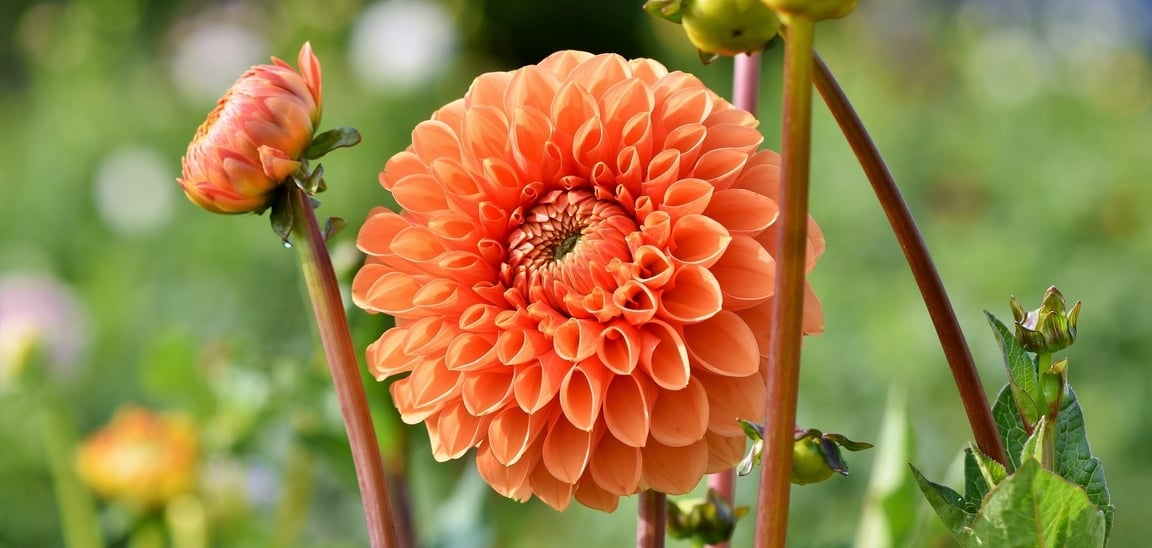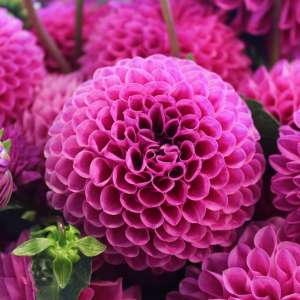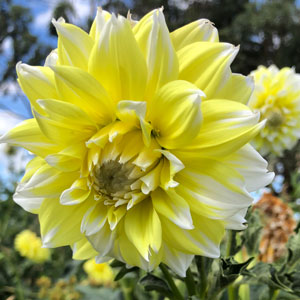Guide to Planting and Growing Dahlias

No summer floral display is complete without striking, sculptural dahlia plants. With a dazzling range of forms, colours and sizes to choose from, there’s something for everyone. Borders (both tall and low), mixed beds and pots can all be coloured in with these vibrant beauties, which also make wonderful cut flowers.
The good news for those that love these impressive flowers is that they’re not too difficult to grow. Spring to early summer is the best time for planting dahlia tubers in the ground. Depending on what variety you choose, you’ll see flowers from summer through autumn, and in some cases (such as with Tree Dahlias) even into early winter.
The Season Ahead
To make the most of the upcoming dahlia season, you’ll need to choose what type of dahlias are right for your garden.
Along with bloom type, be sure to pay attention to the weather resistance and eventual growth size of the different varieties with respect to your available space. For example, Cactus Dahlias are less likely to be weighed down by rain (so they don’t need as much staking as other types), while Delbard varieties are hardy and drought tolerant.
Australia is one of the best places for growing dahlias, so once you’ve got your tubers and learned how to plant dahlias, get ready to enjoy them for years to come.
How to Grow Dahlias in Australia
Growing dahlias to ensure the perfect bloom requires correct planting, an optimal climate and the right soil.
There are a few crucial things to know about growing dahlias, such as how to plant the tubers, watering frequency, the right fertiliser to use, how to stake and more.
How to Plant Dahlia Tubers
When getting started with dahlias, plant the tuber around 10cm deep, with the growing tip a little under the soil surface facing up, and then water them in well. If you’re looking to plant a few of them, it is important that you are planting dahlia bulbs at a density of around 60cm apart. Tall varieties will need staking and you can do this at planting time to minimise damage to the tubers.
In spring, it’s a good idea to disbud the smaller side shoots, leaving one central flower at the top. This allows the central flower to grow big and strong without having to compete for water and food with other flower buds. During this time, you can also take the dahlia tubers out of the ground and divide them up into singular tubers (ensuring they have eyes) and wait for them to grow a shoot. Once you see a shoot, plant and nip off the top bud after six pairs of leaves have grown.
Watering and Fertilising Dahlias
Except in very dry conditions, water your dahlias lightly until the plants have grown to around 15cm high, as an excess of water can cause the tubers to rot before they’ve had an opportunity to grow.
Once your dahlias have reached over 15cm, it is important to keep the soil moderately moist, watering them once or twice a week. Be cautious not to over-water, as this can lead to rot. Wilted leaves often indicate under-watering.
Dahlias benefit from regular feeding. Use a balanced, slow-release fertilizer at planting time and consider a liquid fertiliser every few weeks during the growing season.
Pest and Disease Management
Dahlias can be prone to pests like aphids and spider mites, and diseases such as powdery mildew. Natural methods, like introducing beneficial insects, can be effective. For severe infestations, a pesticide might be necessary. Always follow manufacturer guidelines if using chemicals and consider the impact on your garden’s ecosystem.
Staking and Supporting
Taller dahlia varieties often require support to thrive. Staking should be done early in the growing season or even before planting the tubers to avoid damaging roots later on. You can use garden stakes, cages or sturdy branches. Secure the stems to the support using soft ties, ensuring not to restrict growth. This will keep your dahlias upright and prevent damage from wind or the weight of blooms.
Pruning Dahlias
Pruning dahlias is essential for promoting vigorous growth and bountiful blooms. Start by pinching off the top set of leaves once the plant is about 30–40 centimetres tall. This encourages the plant to branch out. Throughout the season, regularly deadhead spent flowers by cutting them back to the next set of leaves. This keeps the plant looking tidy and encourages more blooms.
In autumn, cut back the stems to about 15 centimetres above the ground as the plant enters dormancy. This will prepare your dahlias for a healthy return next growing season.
Climate
Successfully growing dahlias is very achievable in the right climate. Dahlias prefer cooler climates, but can also grow in temperate and tropical climates depending on the variety. As a general rule, dahlia flowers are most likely to bloom in climates that don’t experience heavy frosts.
If you live in one of Australia’s frostier areas, you can help your dahlias grow by moving them in the winter and keeping them in a dry place. For those in particularly warm climates, it can be beneficial to plant dahlia tubers in a section of your garden that gets sufficient sunlight in the morning and shade in the afternoon.
Where to Plant Dahlias
Planting dahlia tubers in nutrient-rich, moist and well-drained soil will help them bloom into beautiful flowers. Dahlia bulbs and tubers thrive in soil that is filled with well-rotted organic compost, manure and leaf mould. When deciding if the soil is suited for growing dahlias, ensure that it can drain water well while still remaining moist afterwards.
Can Dahlias Grow in Pots?
Many gardeners are excited to grow dahlias but don’t have much outdoor space, leaving them to wonder: can you grow dahlias in pots? Fortunately, most dahlia varieties thrive in pots, making them an excellent choice for adding splashes of colour to patios and balconies.
When planting dahlias in pots, it’s important to choose a pot with good drainage to prevent waterlogging. A pot that’s at least 30cm in diameter is ideal for giving the tubers enough room to grow. Using a quality potting mix and adding a slow-release fertiliser will help the dahlias bloom beautifully. For taller varieties, it’s a good idea to add stakes for support.
Do Dahlias Need Full Sun?
Dahlias flourish best when they receive ample sunlight, ideally at least 6–8 hours of direct sunlight per day. Full sun encourages the growth of sturdy stems and abundant, vibrant blooms. However, in particularly hot climates, dahlias can benefit from some afternoon shade to protect them from intense heat which could cause stress to the plants.
Essentially, while full sun is generally favourable for dahlias, it’s important to observe how your plants react and possibly provide some shade during the hottest part of the day in warmer regions.
When Do You Plant Dahlias In Australia?
The best time to plant dahlias is between October and November, especially if you want to see blooms around Christmas and in the new year. When planting, choose a position with full sun to light shade that is protected from strong winds as much as possible. Use well-drained soil that’s enriched with plenty of well-rotted organic matter.
How Tall Do Dahlias Grow?
Dahlia varieties vary significantly in height. For example, Dahlia Dwarf has a compact form and reaches around 30cm in height, while many other dahlia varieties can reach heights of up to 2m. The most striking of all, the Tree Dahlia, towers over the others, often growing to several metres.
Understanding the growth heights of the specific dahlia variety you select is vital for the proper arrangement and aesthetic balance in your garden, so it’s important to do your research.
Dormancy
While dahlias are often happy to be left undisturbed for years, it is best to lift and separate them every second winter. This is especially necessary if your soil stays damp over winter, as this can cause the tubers to rot – for this reason, it’s best to start with well-drained soil.
When lifting, you’ll need to make sure they don’t dry out entirely. Covering them with dirt or sawdust will help avoid this. To divide your tubers, make sure each division has some of the old stem attached, as this is where the new growth will emerge from.
When spring comes around again, the tubers are ready to be replanted, and the cycle begins anew.
Cut Dahlia Flowers
Cut flowers last up to a week in a vase, making dahlias a popular addition to arrangements. Cutting flowers for this purpose, or deadheading if you prefer to leave them on the plant, will encourage further flowering.
Dahlia Varieties
Garden Express has a huge selection of dahlia varieties available. Get ready for dahlia heaven and explore our extensive range, or take a look at some of our favourites below.
Cactus Dahlia
Cactus Dahlias are an absolute treasure for any garden with their spiky, needle-like petals that burst into a variety of vibrant colours. Unlike the name suggests, they are not related to cacti but are called so because of their distinct, pointy petals.
They are especially resilient to rainy weather and don’t require much staking, making them low-maintenance stars of your garden. Their dramatic look also makes them ideal for eye-catching floral arrangements.
Dahlia Ball
Imagine perfectly shaped colourful orbs sitting atop lush green stems and you have the Ball Dahlia. These beauties produce a profusion of tightly packed round blooms, reminiscent of vintage floral decorations. Their structured shape provides a delightful contrast to more whimsical garden elements and they work well in both formal and cottage garden settings.
Dahlia Dark Foilage
The mysterious Dahlia Dark Foliage variety combines the classic beauty of Dahlia flowers with rich, dark leaves. This stunning contrast makes them an excellent choice for adding depth to your garden. The deep foliage acts as a backdrop that makes the vibrant colours of the flowers truly pop.
Decorative Dahlia
Considered the showstoppers of the dahlia world, expect large lavish blooms and lush foliage that can be the centrepiece of any garden. These flowers demand attention and are ideal for garden beds or large pots. The intricate petal patterns and extensive colour range make them versatile for any garden design.
Dahlia Dwarf
The miniature Dahlia Dwarf variety is perfect for gardeners who are short on space but big on ambition. These petite plants can liven up borders, pots or small garden spaces. Despite their small size, they are prolific bloomers and provide an abundance of vibrant flowers throughout the summer.
Dahlia Giant Dinner Plate
The awe-inspiring Dahlia Giant Dinner Plate boasts enormous, saucer-sized flowers that are sure to make a big impact. These are the giants of the Dahlia world, with flowers that can be as large as 30cm across. They are perfect for making a bold statement in your garden, and they’re also fantastic in pots.
Dahlia Waterlily
Dahlia Waterlilies are elegant and serene, with blooms that resemble waterlily flowers. Their smooth, rounded petals are arranged in multiple layers, creating a delicate, soothing effect. They are ideal for adding a touch of tranquillity and sophistication to any garden or floral arrangement.
Dahlia Delbards
Originating in France, Dahlia Delbards provide a vibrant explosion of colours and shapes. Hardy and dry-tolerant, these dahlias are well-adapted to the hot Australian summers. Delbards are known for their unique combination of robust growth and exquisite, showy flowers that are ideal for cutting.
Pompone Dahlia
Think of tiny, perfect, floral spheres and you’ll have an image of the Pompone Dahlia. This variety is characterised by double blooms with rounded florets, often not much larger than a golf ball. Their intricate, densely packed petals create a captivating geometric pattern. Ideal for adding texture and variety to your garden, Pompone Dahlias are also long-lasting cut flowers.
Tree Dahlias
Majestic and towering, Tree Dahlias are not your typical garden variety. Reaching heights of up to six metres, they are more like shrubs than typical dahlias. Their stems are woody and their flowers, though small, appear in clusters, gracing the top of the plant. This makes them an ideal choice for creating a natural screen or for a focal point in a large garden.
Due to their size, Tree Dahlias require some support and a bit more care, but are well worth the effort for their impressive presence.
Dahlia Mixes
If you love surprises, Garden Express’s dahlia mixes are the perfect choice to liven your property in the summer. These blends combine various types, colours and sizes of dahlias. This is a fantastic way to create a dynamic garden display.
The mixes are particularly useful for new gardeners who want a range of dahlias without the need to select each variety individually.
Dahlia Collections
When you are looking for diversity in your dahlias, Garden Express’s dahlia collections provide a brilliant burst of colours, shapes and sizes. These collections are thoughtfully curated to create a symphony of hues in your garden. They offer a wonderful shortcut to a well-coordinated explosion of colours and forms.
Order Dahlias From Garden Express Today
Located in Victoria’s scenic Yarra Valley in the Monbulk-Silvan horticultural region, Garden Express offers a wide range of horticultural services. Since the 1800s, this area has grown both ornamental and produce crops. The Yarra Valley is home to a variety of bulb farms, tulip fields, roses and raspberries growers, to name a few.








